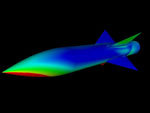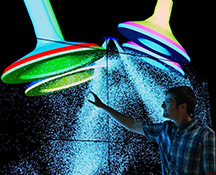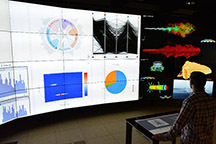ARL DSRC
 The Army Research Laboratory (ARL) has a deep, ingrained heritage of supporting
U.S. warfighters, a tradition predating World War II. Since 1943, the ARL (then known
as the Ballistic Research Laboratory or BRL) has been at the vanguard of modern computing,
providing ballistic calculations and firing tables that were vital to the Allied victory
in World War II and ultimately becoming the first permanent installation of a strategic
asset for battlefield computations and weapons development.
The Army Research Laboratory (ARL) has a deep, ingrained heritage of supporting
U.S. warfighters, a tradition predating World War II. Since 1943, the ARL (then known
as the Ballistic Research Laboratory or BRL) has been at the vanguard of modern computing,
providing ballistic calculations and firing tables that were vital to the Allied victory
in World War II and ultimately becoming the first permanent installation of a strategic
asset for battlefield computations and weapons development.
Today the ARL DSRC is one of five world class computational science facilities supporting the DoD research, development, and test and evaluation communities. For decades, the ARL DSRC has been a leader in providing advanced high performance computing resources and cutting-edge computational solutions, to scientists and researchers across the DoD. This has fueled a steady increase in modeling and simulation quality, supporting complex computational science and engineering applications and enabling DoD researchers and scientists to design and develop better weapons systems at a faster pace and increase the security of our nation.
In partnership with the High Performance Computing Modernization Program (HPCMP), the ARL DSRC makes available powerful HPC systems, provides advanced software packages, enables high-speed secure network access, provides accessible mass storage for data, and supplies expert staff to assist users with the complexities of these resources. All at no cost to users or their programs.
Systems
Our unclassified HPC systems are accessible through the Defense Research and Engineering Network (DREN) to all active customers. Our current systems include:
 Jean - a Liqid system located at the ARL DSRC.
It has 494 standard compute nodes, 24 large-memory nodes, 36 AI/ML nodes, and 24 visualization
nodes.
Jean - a Liqid system located at the ARL DSRC.
It has 494 standard compute nodes, 24 large-memory nodes, 36 AI/ML nodes, and 24 visualization
nodes.
 Ruth - an HPE Cray EX system located at the
ARL DSRC. It has 640 standard compute nodes, 4 large-memory nodes, 16 AI/ML nodes, and
24 visualization nodes.
Ruth - an HPE Cray EX system located at the
ARL DSRC. It has 640 standard compute nodes, 4 large-memory nodes, 16 AI/ML nodes, and
24 visualization nodes.
For information on restricted systems, see the Restricted Systems page (PKI required).
Services
For assistance with unclassified systems, please contact the HPC Help Desk.
For other issues, Click to view more information.
Data Transfer Requests
Before requesting a data transfer, please read the instructions. Then download, complete, and submit the appropriate form.
Software Requests
General: To request general software installation without a procurement, please contact the HPC Help Desk.
Special Procurements: To request the purchase of software that will utilize considerable hours on ARL DSRC resources, users may contact the ARL DSRC Help Desk.
ARL DSRC Service Requests
For requests related to restricted systems or accounts, or for services not provided by the HPC Help Desk, please email the ARL DSRC Help Desk or call 1-800-ARL-1552 (1-800-275-1552) or 410-278-1700 between the hours of 8:00 AM - 5:00 PM Eastern, Monday - Friday (excluding federal holidays).
Requesting a Classified Account
In addition to the normal requirements for getting an HPCMP account, as found on Obtaining an Account , users requesting classified accounts must also send a Visit Request (VR) to ARL. You may save time by asking your security office to send a VR to both ERDC and ARL DSRC security offices at the same time. For questions about sending a VR for classified access, contact the ARL DSRC S/AAA:
- Email: mailto:arl-dsrc-saaa@arl.hpc.mil
- Phone: 410-278-6217
The ARL DSRC Outreach team can be reached by emailing outreach@arl.hpc.mil
Visit
If you're planning a visit to the ARL DSRC, we would like to help
make your visit go as smoothly as possible. Before finalizing your
travel plans, please review the following information and coordinate
with your ARL DSRC POC and your organization's HPC Service/Account
Approval Authority (S/AAA) to ensure that all of your credentials
are in place and all visit requirements are met.
Click to view more information
Pre-Trip Instructions
Please contact Ms. Tameka Jones, at: tameka.n.jones7.ctr@mail.mil if you need guidance regarding how to contact your organization’s S/AAA.
- All security clearances should be submitted in advance of the visit to the ARL
Security Office.
U.S. Army Research Laboratory
ATTN: RDRL-CIH-M
Aberdeen Proving Ground, MD 21005
DISS SMO Code W26218
Phone: 410-278-5574
Fax: 410-278-6252
- All security clearances must also be faxed to the U.S. Army Research Laboratory (ARL) Visitor's Desk at 410-278-6362.
- Non-U.S. citizens representing a foreign government,
industry, or academic institution must do the following:
- Submit a visit request to the Security Specialist at 301-394-4977, or fax at 301-394-4583
- Submit this request via the correct official diplomatic channels prior to the visit.
- U.S. Citizens representing industry or academic institution must contact their ARL point of contact at least 48 hours prior to arrival.
On-Arrival Instructions
- Visitors WITH a Government ID (CAC or other Government ID) can enter APG using either the MD 22 Harford Gate OR the MD 715 Maryland Gate. Show the guard your ID as you enter.
- Visitors WITHOUT a Government ID MUST enter APG using the MD 715 Maryland Gate. These visitors will need to sign in at the VISITOR CENTER, located off of Maryland Blvd. A Visitor Pass good for 6 months will be issued. They must then backtrack to Maryland Blvd. to continue towards the gate.
- Visitors WITHOUT a Government ID in the same vehicle as a visitor WITH a Government ID can enter at either gate.
- To obtain a vehicle security pass, provide driver's license, vehicle registration and proof of insurance.
- All visitors to the Army Research Laboratory DoD Supercomputing Resource Center are required to register at the main ARL visitor desk in Building 3410. Those visitors not having a current security clearance on file at ARL will be escorted at all times.
Local Information
The ARL DSRC is located on the Aberdeen Proving Ground. Visitors to the DSRC can download and print the Aberdeen Proving Ground Visitors Guide, which contains important contact information, security reminders, a list of local hotels, and a map of the base. This guide also has the latest COVID information and restrictions.
Security Contact Information
- Security Specialist - 301-394-4977 fax: 301-394-4583
- ARL Visitor's Desk - phone: 410-278-5217 fax: 410-278-6362
- ARL Security Office
U.S. Army Research Laboratory
ATTN: RDRL-CIH-M
Aberdeen Proving Ground, MD 21005
DISS SMO Code W26218
Phone: 410-278-5574
Fax: 410-278-6252
DAAC
The ARL Data Analysis & Assessment Center (DAAC) is focused on providing the facilities, software tools and the experience to enable the understanding of physics-based computations by researchers.
Learn more, Click to view more information.
ARL Data Analysis and Assessment Center
HPCMP Data Analysis and Assessment Center (DAAC)
What is data analysis?
 Data analysis is an evolving technology that allows scientists to
comprehend large, transient datasets visually. Using multi-dimensional,
data animations, researchers can literally see previously unobservable
information in the results of gridded numerical computations,
non-geometric calculations, or experimental data. The ability to
share these results with disparate groups motivates the development
of new display technologies, including research initiatives in a
variety of hardware and software technologies.
Data analysis is an evolving technology that allows scientists to
comprehend large, transient datasets visually. Using multi-dimensional,
data animations, researchers can literally see previously unobservable
information in the results of gridded numerical computations,
non-geometric calculations, or experimental data. The ability to
share these results with disparate groups motivates the development
of new display technologies, including research initiatives in a
variety of hardware and software technologies.
Data analysis serves two very different purposes: First, it helps scientists and engineers solve problems by enabling detailed examinations of data, though the results may not be intuitive to a general audience. Second, it helps to explain and promote a particular science to a wider audience by making complex topics more easily understood.
 Data analysis, assessment, and visualization are key components of
the ARL DSRC. Along with high performance computers, advanced networking,
and staff infrastructure, they provide a methodology to explore,
define, and present the results of computations from HPC systems.
The ARL Data Analysis & Assessment Center (DAAC) develops, maintains,
and supports robust client-server based applications that enable
computational scientists to fully utilize the power of the DoD HPCMP
resources from their desktop as a natural and intuitive part of
their analysis effort. ARL DAAC team members work directly with
customers to guide and assist in the use of application software
and develop custom applications and animations in support of unique
customer requests.
Data analysis, assessment, and visualization are key components of
the ARL DSRC. Along with high performance computers, advanced networking,
and staff infrastructure, they provide a methodology to explore,
define, and present the results of computations from HPC systems.
The ARL Data Analysis & Assessment Center (DAAC) develops, maintains,
and supports robust client-server based applications that enable
computational scientists to fully utilize the power of the DoD HPCMP
resources from their desktop as a natural and intuitive part of
their analysis effort. ARL DAAC team members work directly with
customers to guide and assist in the use of application software
and develop custom applications and animations in support of unique
customer requests.
The DAAC Mission
- Develop new techniques for exploiting high-performance computing technology
- Promote the use of data analysis and visualization within ARL and the DoD
- Provide stable, production-quality analysis applications and computing environments
- Develop and distribute visual analysis applications to critical HPCMP resources
- Serve as a focal point to compile visualization work for use in promoting the DoD
Working with researchers within ARL, other DOD facilities, national laboratories, and commercial partners, the ARL DAAC has accomplished work in virtually every major Computational Technology Area (CTA). The team has numerous initiatives that extend the boundaries of visualization, including the use of HPC resources, both locally developed and supported through various technology programs.
Software Downloads, Tutorials, Documentation
The ARL DAAC has focused on the support of the most widely used visualization and analysis tools used within the HPCMP.
Support
For assistance with data analysis and visualization, contact the HPC Help Desk or contact the DAAC team directly.
Facilities
Laboratory (Red Cell)
 The ARL Visualization Laboratory known as the "Red Cell", is a
dedicated room in the ARL DSRC with numerous interactive display
technologies. Most notably, a curved 24-panel display wall with
twenty-four 55" thin bezel monitors and a control system to provide
high resolution output (11520 x 4320 pixels) from a dedicated visualization
cluster or various other inputs. 12 tracking cameras allow interaction
with applications and user data.
The ARL Visualization Laboratory known as the "Red Cell", is a
dedicated room in the ARL DSRC with numerous interactive display
technologies. Most notably, a curved 24-panel display wall with
twenty-four 55" thin bezel monitors and a control system to provide
high resolution output (11520 x 4320 pixels) from a dedicated visualization
cluster or various other inputs. 12 tracking cameras allow interaction
with applications and user data.
The lab includes various immersive technologies. The DAAC Team here at ARL are developing software and extensions to use these technologies in novel ways to immerse the users in their datasets.
The team also uses mixed-reality devices to heighten the visualization experience, allowing the dataset visualization to appear in the room to a user wearing the device. The user can then walk around and examine the data as if it is right in front of them.
Hardware
 The ARL DSRC has numerous systems for visualizing your data, including
all of our production HPC systems via the Secure Remote Desktop
(SRD). This is particularly convenient as the data does not need to
be moved to a different system.
The ARL DSRC has numerous systems for visualizing your data, including
all of our production HPC systems via the Secure Remote Desktop
(SRD). This is particularly convenient as the data does not need to
be moved to a different system.
The lab also has a dedicated visualization cluster with twenty-four
1920 x 1080 outputs that feed the Red Cell tiled display.
Publications
Current and past editions of the ARL Newsletter and other publications are available on the publications page.



